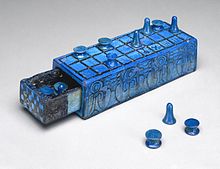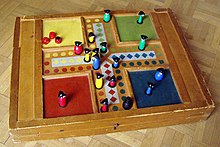Game

A game is a structured type of
Games are sometimes played purely for enjoyment, sometimes for achievement or reward as well. They can be played alone, in teams, or online; by amateurs or by professionals. The players may have an audience of non-players, such as when people are entertained by watching a chess championship. On the other hand, players in a game may constitute their own audience as they take their turn to play. Often, part of the entertainment for children playing a game is deciding who is part of their audience and who is a player. A toy and a game are not the same. Toys generally allow for unrestricted play whereas games present rules for the player to follow.
Key components of games are goals,
Attested as early as 2600 BC,[2][3] games are a universal part of human experience and present in all cultures. The Royal Game of Ur, Senet, and Mancala are some of the oldest known games.[4]
Definitions
Ludwig Wittgenstein
Ludwig Wittgenstein was probably the first academic philosopher to address the definition of the word game. In his Philosophical Investigations,[5] Wittgenstein argued that the elements of games, such as play, rules, and competition, all fail to adequately define what games are. From this, Wittgenstein concluded that people apply the term game to a range of disparate human activities that bear to one another only what one might call family resemblances. As the following game definitions show, this conclusion was not a final one and today many philosophers, like Thomas Hurka, think that Wittgenstein was wrong and that Bernard Suits' definition is a good answer to the problem.[6]
Roger Caillois
French sociologist Roger Caillois, in his book Les jeux et les hommes (Games and Men)(1961),[7] defined a game as an activity that must have the following characteristics:
- fun: the activity is chosen for its light-hearted character
- separate: it is circumscribed in time and place
- uncertain: the outcome of the activity is unforeseeable
- non-productive: participation does not accomplish anything useful
- governed by rules: the activity has rules that are different from everyday life
- fictitious: it is accompanied by the awareness of a different reality
Chris Crawford
Game designer Chris Crawford defined the term in the context of computers.[8] Using a series of dichotomies:
- Creative expression is art if made for its own beauty, and entertainment if made for money.
- A piece of entertainment is a interactive. Movies and books are cited as examples of non-interactive entertainment.
- If no goals are associated with a plaything, it is a toy. (Crawford notes that by his definition, (a) a toy can become a game element if the player makes up rules, and (b) The Sims and SimCity are toys, not games.) If it has goals, a plaything is a challenge.
- If a challenge has no "active agent against whom you compete", it is a puzzle; if there is one, it is a conflict. (Crawford admits that this is a subjective test. Video games with noticeably algorithmic artificial intelligence can be played as puzzles; these include the patterns used to evade ghosts in Pac-Man.)
- Finally, if the player can only outperform the opponent, but not attack them to interfere with their performance, the conflict is a competition. (Competitions include racing and figure skating.) However, if attacks are allowed, then the conflict qualifies as a game.
Crawford's definition may thus be rendered as: an interactive, goal-oriented activity made for money, with active agents to play against, in which players (including active agents) can interfere with each other.
Other definitions, however, as well as history, show that entertainment and games are not necessarily undertaken for monetary gain.
Other definitions
- "Voluntary effort to overcome unnecessary obstacles." Bernard Suits[9]
- "A game is a form of art in which participants, termed players, make decisions in order to manage resources through game tokens in the pursuit of a goal." (Chutes and Ladders, Candy Land, and Warare not technically games any more than a slot machine is.
- "A game is a form of play with goals and structure." (Kevin J. Maroney)[11]
- "A game is a system in which players engage in an artificial conflict, defined by rules, that results in a quantifiable outcome." (Katie Salen and Eric Zimmerman)[12]
- "A game is an activity among two or more independent decision-makers seeking to achieve their objectives in some limiting context." (Clark C. Abt)[13]
- "At its most elementary level then we can define game as an exercise of voluntary control systems in which there is an opposition between forces, confined by a procedure and rules in order to produce a disequilibrial outcome." (Elliot Avedon and Brian Sutton-Smith)[14]
- "To play a game is to engage in activity directed toward bringing about a specific state of affairs, using only means permitted by specific rules, where the means permitted by the rules are more limited in scope than they would be in the absence of the rules, and where the sole reason for accepting such limitation is to make possible such activity." (Bernard Suits)[15]
- "When you strip away the genre differences and the technological complexities, all games share four defining traits: a goal, rules, a feedback system, and voluntary participation." (Jane McGonigal)[16]
Gameplay elements and classification
Games can be characterized by "what the player does".[8] This is often referred to as gameplay. Major key elements identified in this context are tools and rules that define the overall context of game.
Tools
Games are often
Many game tools are tokens, meant to represent other things. A token may be a pawn on a board, play money, or an intangible item such as a point scored.
Games such as
course, even with the same cars.Rules and aims
Games are often characterized by their tools and rules. While rules are
Rules generally determine
The rules of a game may be distinguished from its aims.). There may also be intermediate aims, which are tasks that move a player toward winning. For instance, an intermediate aim in football is to score goals, because scoring goals will increase one's likelihood of winning the game, but is not alone sufficient to win the game.
An aim identifies a
Skill, strategy, and chance
A game's tools and rules will result in its requiring skill, strategy, luck, or a combination thereof, and are classified accordingly.
Single-player games
Most games require multiple players. However, single-player games are unique in respect to the type of challenges a player faces. Unlike a game with multiple players competing with or against each other to reach the game's goal, a one-player game is a battle solely against an element of the environment (an artificial opponent), against one's own skills, against time, or against chance. Playing with a yo-yo or playing tennis against a wall is not generally recognized as playing a game due to the lack of any formidable opposition. Many games described as "single-player" may be termed actually puzzles or recreations.
Multiplayer games

A multiplayer game is a game of several players who may be independent opponents or teams. Games with many independent players are difficult to analyze formally using game theory as the players may form and switch coalitions.[20] The term "game" in this context may mean either a true game played for entertainment or a competitive activity describable in principle by mathematical game theory.
Game theory
If cooperation between players is allowed, then the game becomes more complex; many concepts have been developed to analyze such games. While these have had some partial success in the fields of economics, politics and conflict, no good general theory has yet been developed.[21]
In quantum game theory, it has been found that the introduction of quantum information into multiplayer games allows a new type of equilibrium strategy not found in traditional games. The entanglement of player's choices can have the effect of a contract by preventing players from profiting from what is known as betrayal.[22]
Types

Games can take a variety of forms, from competitive sports to board games and video games.
Sports

Many sports require special equipment and dedicated playing fields, leading to the involvement of a community much larger than the group of players. A city or town may set aside such resources for the organization of sports leagues.
Popular sports may have
Lawn games
Tabletop games
A tabletop game is a game where the elements of play are confined to a small area and require little physical exertion, usually simply placing, picking up and moving game pieces. Most of these games are played at a table around which the players are seated and on which the game's elements are located. However, many games falling into this category, particularly party games, are more free-form in their play and can involve physical activity such as mime. Still, these games do not require a large area in which to play them, large amounts of strength or stamina, or specialized equipment other than what comes in a box.
Dexterity and coordination games
This class of games includes any game in which the skill element involved relates to manual dexterity or hand-eye coordination, but excludes the class of video games (see below). Games such as
Board games

Board games use as a central tool a board on which the players' status, resources, and progress are tracked using physical tokens. Many also involve dice or cards. Most games that simulate war are board games (though a large number of video games have been created to simulate strategic combat), and the board may be a map on which the players' tokens move. Virtually all board games involve "turn-based" play; one player contemplates and then makes a move, then the next player does the same, and a player can only act on their turn. This is opposed to "real-time" play as is found in some card games, most sports and most video games.
Some games, such as
Most other board games combine strategy and luck factors; the game of
Board game groups include
Card games

Card games use a deck of cards as their central tool. These cards may be a standard
Some board games include a deck of cards as a gameplay element, normally for randomization or to keep track of game progress. Conversely, some card games such as Cribbage use a board with movers, normally to keep score. The differentiation between the two genres in such cases depends on which element of the game is foremost in its play; a board game using cards for random actions can usually use some other method of randomization, while Cribbage can just as easily be scored on paper. These elements as used are simply the traditional and easiest methods to achieve their purpose.
Dice games

Dice games use a number of
Domino and tile games
Domino games are similar in many respects to card games, but the generic device is instead a set of tiles called
Variations of traditional dominoes abound:
Some other games use tiles in place of cards;
that uses a set of tiles with card-like values and art.Lastly, some games use graphical tiles to form a board layout, on which other elements of the game are played.
Pencil and paper games
Pencil and paper games require little or no specialized equipment other than writing materials, though some such games have been commercialized as board games (
Guessing games
A guessing game has as its core a piece of information that one player knows, and the object is to coerce others into guessing that piece of information without actually divulging it in text or spoken word.
Video games
Video games are computer- or microprocessor-controlled games. Computers can create virtual spaces for a wide variety of game types. Some video games simulate conventional game objects like cards or dice, while others can simulate environs either grounded in reality or fantastical in design, each with its own set of rules or goals.
A computer or video game uses one or more
There are many genres of video game; the first commercial video game, Pong, was a simple simulation of table tennis. As processing power increased, new genres such as adventure and action games were developed that involved a player guiding a character from a third person perspective through a series of obstacles. This "real-time" element cannot be easily reproduced by a board game, which is generally limited to "turn-based" strategy; this advantage allows video games to simulate situations such as combat more realistically. Additionally, the playing of a video game does not require the same physical skill, strength or danger as a real-world representation of the game, and can provide either very realistic, exaggerated or impossible physics, allowing for elements of a fantastical nature, games involving physical violence, or simulations of sports. Lastly, a computer can, with varying degrees of success, simulate one or more human opponents in traditional table games such as chess, leading to simulations of such games that can be played by a single player.
In more open-ended video games, such as sandbox games, a virtual environment is provided in which the player may be free to do whatever they like within the confines of a particular game's universe. Sometimes, there is a lack of goals or opposition, which has stirred some debate on whether these should be considered "games" or "toys". (Crawford specifically mentions Will Wright's SimCity as an example of a toy.)[8]
Online games
Modern online games are played using an Internet connection; some have dedicated client programs, while others require only a web browser. Some simpler browser games appeal to more casual game-playing demographic groups (notably older audiences) that otherwise play very few video games.[23]
Role-playing games
Role-playing games, often abbreviated as RPGs, are a type of game in which the participants (usually) assume the roles of characters acting in a fictional setting. The original role playing games – or at least those explicitly marketed as such – are played with a handful of participants, usually face-to-face, and keep track of the developing fiction with pen and paper. Together, the players may collaborate on a story involving those characters; create, develop, and "explore" the setting; or vicariously experience an adventure outside the bounds of everyday life. Pen-and-paper role-playing games include, for example, Dungeons & Dragons and GURPS.
The term role-playing game has also been appropriated by the video game industry to describe
Business games
Business games can take a variety of forms, from interactive board games to interactive games involving different props (balls, ropes, hoops, etc.) and different kinds of activities. The purpose of these games is to link to some aspect of organizational performance and to generate discussions about business improvement. Many business games focus on organizational behaviors. Some of these are computer simulations while others are simple designs for play and debriefing. Team building is a common focus of such activities.
Simulation
The term "game" can include simulation
See also
- Game club– Association of people united by a common interest or goal
- Game mechanics – Construct, rule, or method designed for interaction with a game's state
- Gamer – Hobbyist who plays video games
- Girls' games and toys– Subset of toy and games that appeal to female children
- History of games
- Learning through play – Concept in education and psychology
- List of games– Overview of and topical guide to games
- Ludeme – Basic unit of play
- Ludibrium – Latin word
- Ludology– Study of games and the act of playing them
- Ludomania– Repetitive gambling despite demonstrable harm and adverse consequences
- Mobile game – Video game played on a mobile device
- N-player game – a game with n-players, typically used in contrast to 2-player games
- Personal computer game– Electronic game played on a personal computer
References
- ^ "Definition of GAME". Merriam-Webster. Retrieved 7 May 2017.
- ^ Soubeyrand, Catherine (2000). "The Royal Game of Ur". The Game Cabinet. Retrieved 5 October 2008.
- ^ Green, William (19 June 2008). "Big Game Hunter". 2008 Summer Journey. Time. Archived from the original on 20 June 2008. Retrieved 5 October 2008.
- ^ "History of Games". MacGregor Historic Games. 2006. Retrieved 5 October 2008.
- ISBN 978-0-631-23127-1.
- ^ "Was Wittgenstein Wrong About Games?". Nigel Warburton. 2007. Retrieved 28 June 2013.
- ^ Caillois, Roger (1957). Les jeux et les hommes. Gallimard.
- ^ ISBN 978-0-88134-117-1.
- ^ Ross, Greg (4 June 2018). "Podcast Episode 203: Notes and Queries". Futility Closet. Retrieved 25 December 2023.
- ^ a b Costikyan, Greg (1994). "I Have No Words & I Must Design". Archived from the original on 12 August 2008. Retrieved 17 August 2008.
- ^ Maroney, Kevin (2001). "My Entire Waking Life". The Games Journal. Archived from the original on 21 November 2008. Retrieved 17 August 2008.
- ISBN 978-0-262-24045-1.
- ISBN 978-0-8191-6148-2.
- ISBN 978-0-471-03839-9.
- S2CID 119699909.
- ISBN 978-0-14-312061-2.
- JSTOR 2184198.
- ^ ISSN 0003-2638.
- ^ Kemp, Gary (2007). "Assertion as a practice". Truth and Speech Acts: Studies in the Philosophy of Language.
- ISBN 978-0-262-02444-0.
- ^ ISBN 978-0-387-98419-3.
- S2CID 32056578.
- S2CID 220317720.
- ^ Woodcock, Bruce Sterling (2008). "An Analysis of MMOG Subscription Growth". Retrieved 16 November 2008.
- ^ "Roleplay Simulation for Teaching and Learning". Archived from the original on 5 February 2008.
- ^ "Roleplay Simulation Gamer Site". Playburg.com. Retrieved 29 July 2009.
Further reading
- Avedon, Elliot; ISBN 0-89874-045-2.
